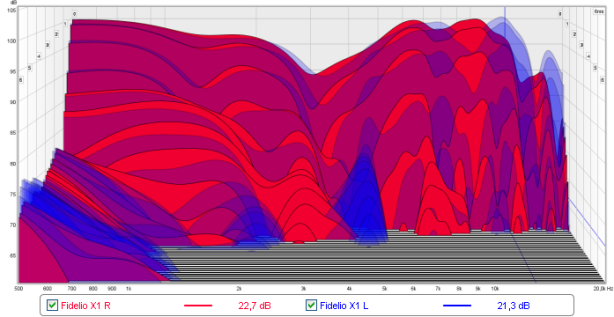Fidelio X1
back to Philips
back to measurements
home
published: Jun-13-2014
NO SMOOTHING is applied to the shown plots. Most measurement sites have some smoothing applied which ‘irons flat’ sharp peaks and ‘wiggles’. I do not use smoothing because some info about sound quality is lost when plots are smoothed.
Aside from a small correction of the microphone itself also some correction in the lowest frequencies is applied to the plots to compensate for the perceived loss of bass when using headphones. This is described HERE in more detail.
A ‘horizontal‘ frequency response curve on the shown frequency response plots on this website thus indicates a perceived ‘flat’ tonal signature.
ALL measurements are made with a good SEAL on a flatbed measurement rig.
The shape of your head, bone structure, pad size, pad ‘softness, (compliance), hair or no hair and or wearing glasses may (drastically) change the frequency response of some headphones, so… your personal experience may differ substantially from these plots.
Frequency response (tonal balance) is the most sound-determining aspect of headphones. A horizontal line shows audible neutral response in the plots on this website. Deviations in different severities at different frequency bands have an effect on the sound character.
The bigger the deviation the stronger the effect.
Below an aid to help determining the sound character of headphones with relation to the frequency response.

Philips Fidelio X1
The Fidelio X1 is Philips‘s flagship headphone. The build quality is excellent and the looks are really great. The picture doesn’t do it justice.
It has been replaced by a newer type (X2) which has replaceable earpads which IMO is a good thing.
The used materials are very nice and seem quality materials.
The detachable cable (ordinary 3.5mm stereo jack) is a good thing. The headband is very soft and comfortable. TheX1 has velours pads.It is clearly intended for home usage even though it has a relatively low impedance (around 30 Ohm). The give away is the fixed (nice looking) 6.3mm stereo jack and thick long cord. There is a 3.5mm converter but you really do not want to use such a heavy construction (big adapter, big 6.3mm plug and thick cord) plugged into your DAP.
It is an open headphone which means that A: you can still hear what’s happening around you and B: others around you can hear what you are playing very well.
So far only positive remarks. BUT there are also some negatives. The velours pad material isn’t as soft to the skin as other velours pads. Directly out of the box it smells considerably (a bit like those NASA foam pillows) but reckon this will go away after a few days.
It won’t be with me long enough to know this for sure though. The reason being my expectation which may have been a tad too high.
Another thing that annoys me is the cable which is a bit stiff and is microphonic. Fortunately the cable can be easily replaced.
The little hears on the velours pads aren’t as ‘comfy’ as Beyerdynamic ones.
Having heard the SHP-9000 below, which sounds very good, and the X1 being twice the price raised expectations.
Below the frequency plot of the ‘high definition’ Fidelio X1 (Left, Right)
Everything from 30Hz to 1kHz is well balanced and sounds good. Also the treble part isn’t raised which ensures it doesn’t sound shrill, sibilant or harsh. The problem area is between 1kHz and 6kHz though. There is a dip there which takes away a bit of the sharpness of voices and instruments which can be a pleasant experience with some (harsher sounding) recordings. On well recorded music it takes away too much and makes the X1 ‘darker’ sounding but without bloat or heavy bass. The treble being present again masks this a bit as you do hear the treble in the proper amount.
Another downside is the treble extension. it drops of quickly above 17kHz (on the left) but on the right it drops off quickly above 13kHz.
In my opinion it doesn’t deserve the ‘high definition’ markings on the nice enclosure. It isn’t high definition and aside from some ‘clarity’ that is missing it also looses out on the finesse in strings and cymbals etc., it lacks ‘air’. I would like to have said it is a reference grade headphone but it is NOT. Even though the looks and quality appear top notch the sound is good to decent and a bit darkish (lack of clarity) but with the right amount of treble. Definitely NOT flagship-type sound quality.
The CSD below shows little to no ringing which actually is good thing… yet… it can’t convince me of it’s purported greatness.

I designed a correction module for the Kameleon amplifier for the X1 and listened to it (and measured it, see plot below). It improved somewhat on tonal balance front but the (now filled-in) missing clarity part is artificial sounding and not very ‘smooth’, some harshness crept in there. As you can see the bottom end (below 30Hz) and the 3kHz ‘part’ measure much better, but the treble roll-off above 13kHz is now even more obvious and made me decide to send it back. There is little that can be done about it as it appears to be a driver issue. Left, Right

Verdict: a nice looking and well made headphone that screams ‘high quality’ but has some let downs on the audio side of things (missing clarity and top-extension). It is NOT a bad sounding headphone but also isn’t a very good sounding headphone.


